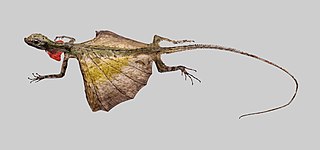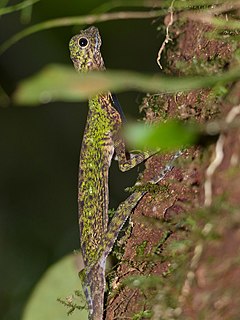
Draco is a genus of agamid lizards that are also known as flying lizards, flying dragons or gliding lizards. These lizards are capable of gliding flight via membranes that may be extended to create wings (patagia), formed by an enlarged set of ribs. They are arboreal insectivores.
Draco is the Latin word for serpent or dragon.

Draco volans, also commonly known as the common flying dragon, is a species of lizard in the family Agamidae. The species is endemic to Southeast Asia. Like other members of genus Draco, this species has the ability to glide using winglike lateral extensions of skin called patagia.

Draco blanfordii, commonly known as Blanford's flying dragon, Blanford’s flying lizard, or Blanford's gliding lizard, is a species of "flying" lizard in the family Agamidae. The species is endemic to Asia, and is capable of gliding from tree to tree.

Draco dussumieri, also known comonly as the Indian flying lizard, the southern flying lizard, and the Western Ghats flying lizard, is a species of lizard in the family Agamidae. The species is capable of gliding from tree to tree. It is found principally in the Western Ghats and some other hill forests of Southern India. It is almost completely arboreal, found on trees in forests and adjoining palm plantations where it climbs trees to forage for insects and glides to adjoining trees by expanding the patagium, loose skin on the sides of the body which is supported by elongated ribs to act as wings. The skin on the sides of the neck is also extended to the sides using the hyoid bones of the tongue as support. During the breeding season males maintain small territories which they defend from other males while courting females. The male has a more colourful patagium than the female, and it prominently extends its yellow dewlap forward in display. Although living almost its entire life in trees, the female descends to the ground to lay eggs in soil. This is the species with the westernmost distribution within the genus Draco, the majority of species occurring in Southeast Asia.

Draco maculatus, commonly known as the spotted flying dragon or spotted gliding lizard, is a species of agamid flying lizard endemic to Southeast Asia. It is capable of gliding from tree to tree.

Draco norvillii, also known as Norvill's flying lizard, is species of agamid flying lizard endemic to India. This species is capable of gliding from tree to tree, and has been recorded gliding up to 50 metres (160 ft). It feeds on insects and other small invertebrates.

Coelurosauravus is a genus of basal diapsid reptiles, known from the Late Permian of Madagascar. Like other members of the family Weigeltisauridae, members of this genus possessed long, rod-like ossifications projecting outwards from the body. These bony rods were not extensions of the ribs but were instead newly developed bones derived from the skin of the animal, a feature unique to weigeltisaurids. It is believed that during life, these structures formed folding wings used for gliding flight, similar to living gliding Draco lizards.

Draco sumatranus, the common gliding lizard, is a species of agamid lizard endemic to Southeast Asia. It has elongated ribs and skin flaps on the sides of its body. When opened, these skin flaps allow it to glide between tree trunks.
A flying lizard is a gliding lizard of genus Draco.

Xianglong is a genus of Cretaceous lizard discovered in the Zhuanchengzi, near Yizhou, Yixian, Liaoning Province of China. It is known from LPM 000666, a single complete skeleton with skin impressions. The specimen comes from the Barremian-age Lower Cretaceous Yixian Formation, near Yizhou. The most notable feature about Xianglong is its bizarre oversized ribs, eight on each side, which were attached to a membrane of body tissue and allowed the lizard to glide. While in its original description it was considered to acrodont lizard, with a cladistic analysis in the same study suggesting that it was grouped with iguanians such as agamines, chamaeleonids, and leiolepidines. it was later shown that this was due to misinterpretation of the crushed skull, and its affinities with other lizards remains unknown.

Draco indochinensis, also known as the Indochinese flying lizard or Indochinese gliding lizard, is a species of agamid lizard endemic to South-east Asia.

Draco melanopogon, commonly known as the black-bearded gliding lizard or black-barbed flying dragon, is a species of agamid "flying lizard" endemic to Southeast Asia.

The Draconinae are a subfamily of reptiles in the family Agamidae found in southern Asia and Oceania. Some taxonomists believe these genera belong to the subfamily Agaminae.

Weigeltisauridae is a family of gliding neodiapsid reptiles that lived during the Late Permian, between 258 and 252 million years ago. Fossils of weigeltisaurids have been found in Madagascar, Germany, Great Britain, and Russia. A possible weigeltisaurid, Wapitisaurus, been found in Early Triassic strata in North America, but its poor preservation makes referral to the group questionable. They are characterized by long, hollow rod-shaped bones extending from the torso that probably supported wing-like membranes. Similar membranes are also found in several other extinct reptiles such as kuehneosaurids and Mecistotrachelos, as well as living gliding lizards, although each group evolved these structures independently.

Draco mindanensis, commonly known as the Mindanao flying dragon or Mindanao flying lizard, is a lizard species endemic to the Philippines. Characterized by a dull grayish brown body color and a vivid tangerine orange dewlap, this species is one of the largest of the genus Draco. It is diurnal, arboreal, and capable of gliding.
Draco guentheri, commonly known as Günther's flying lizard is a species of agamid "flying dragon" endemic to the Philippines.

Draco spilonotus, the Sulawesi lined gliding lizard, is a lizard endemic to Sulawesi. The species is known from various localities in forested areas of Sulawesi.

Draco taeniopterus, the Thai flying dragon, barred flying dragon, or barred gliding lizard, is a species of agamid lizard. It is found in Myanmar, Thailand, Cambodia, and Malaysia.














